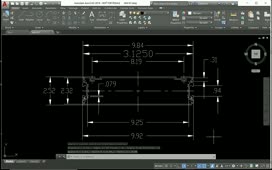A spline is a smooth curve that either passes through or near a given set of points. While you can also create approximations of splines based on polylines, true spline objects are more accurate than splined polylines, they retain their definitions when edited, and they take up less space, resulting in smaller drawing files. Splines are a critical tool for creating curves that will subsequently be used for 3D modeling.
You can use the SPLINE command to create a type of curve known as a non-uniform rational B-spline or NURBS curve. A NURBS curve produces a smooth curve between control vertices or fit points. The spline on the left is drawn using fit points. The spline on the right is drawn using control vertices.
To create a spline, on the Home ribbon, expand the Draw panel. Here you will find two tools for drawing splines. The Spline Fit tool creates a spline using fit points, in which case the spline will pass through the points you select. The Spline CV tool creates a spline using control vertices, in which case the points you select control the shape of the spline, but the spline does not necessarily pass through those points.
When you start the Spline command, there are several options. For example, when creating splines using control vertices, you also set the degree or number of bends that can be created in each span of the spline. The degree can be 1, 2, or 3. A 1-degree spline results in a line; there is no bend. A 2-degree spline results in a parabola; there can be only one bend. A 3-degree spline results in a cubic Bezier curve; there can be two bends. Note that when defining a spline using control vertices, there will be one more control vertex than the number of degrees, so a 3-degree spline has 4 control vertices.
To create a spline using control vertices, expand the Draw panel and click the Spline CV button. After starting the SPLINE command, you can right-click and choose Method from the shortcut menu and then change the method you are using to create the spline. You could then also specify the degree of the spline, but in most cases, you should leave this value set to 3.
The exercise file includes several point objects you can use to create a spline. Make sure that Node is set as a running object snap. Then, click to specify the first point of the spline, and then click to specify successive points. The spline starts off in a direction tangent to the line between the first and second points. As you select additional points, the spline is pulled toward the control vertices but does not pass through them. When you are finished selecting points, you can press ENTER to end the command.
Repeat these steps to create another spline using control vertices. But this time, instead of ending the command by pressing ENTER, right-click and choose the Close option to create a closed spline. Note that the resulting spline does not pass through any of the control vertices.
Expand the Draw panel and click the Spline Fit button. When creating a spline using the Fit method, the shape of the curve is controlled by knots and there are three different knot parameterizations. To change the knot parameterization, right-click and choose the Knot option. When this is set to Chord, the program numbers edit points using decimal values representing their location on the curve. When it is set to Square Root, the program numbers edit points based on the square root of the chordal length between consecutive knots. And when it is set to Uniform, the program numbers edit points with consecutive integers.
Choose the Chord option and then begin specifying points by using the node object snap to snap to the point objects. When using the Fit method, you can also control the start tangency, end tangency, and tolerance. The tangency settings enable you to control the tangent direction. The tolerance value lets you specify how close the spline must pass to the fit points, and is applied to all fit points except for the start and end points of the spline.
In this case, simply create the spline using the default values. When you get to the last point, press ENTER to end the command.
Repeat these steps, but this time, right-click, choose the Tolerance option, and specify a tolerance of 1. Note that you can specify a different tolerance value for each fit point. When you reach the last point, press ENTER to end the command. This time, the spline passes through the first and last points and within 1 unit of the other points.
Repeat this one more time. Each time you create a new spline using the Fit option, the tolerance value is initially reset to 0. When you reach the last point, right-click and choose the Close option to create a closed spline.
The SPLINE command has one other option. Start SPLINE command again and choose the Object option. The program prompts you to select a spline-fit polyline. Click to select the polyline and then right-click to complete the command. The program immediately converts the spline-fit polyline into a true spline.
Source: Autodesk




